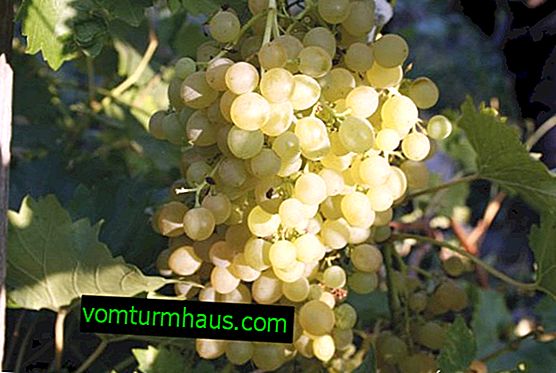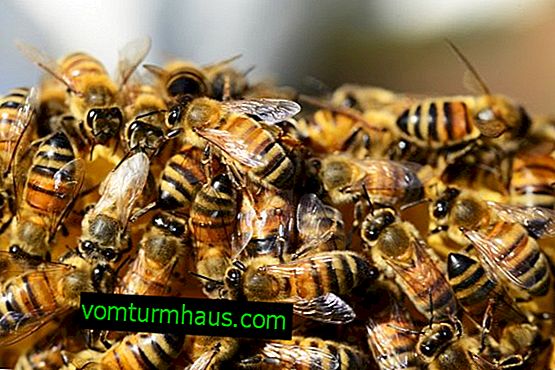Varieties and useful properties for the body of Altai honey
The nature of Altai was not invaded by heavy industry - there is clean air, water and land. The honey produced in this area is environmentally friendly and the most useful of all types of sweet product.
Features and characteristics of Altai honey
The name "Altai" combines several types of nectar, which have their own special characteristics. Product color can be light yellow to transparency, have a greenish tint, red-brown and almost black.

Combines all varieties with several common qualities:
- high viscosity of nectar;
- strong aroma of herbs or berries, flowers;
- sweetness with a slight astringency and a bright finish;
- slow crystallization;
- the ability to preserve all the beneficial properties after thickening;
- shelf life from one year to 15 months.
Did you know? In antiquity, in many countries, instead of currency, expensive products were used: pepper, saffron, honey. With sweet currency in Egypt, Rome, among the Slavic peoples, it was possible to repay a debt, pay a tax or a fine.
Types of Altai honey
The landscape of Altai has a variety of steppes, taiga zones, forest-steppes, meadows, foothills and highlands. Each of these zones differs in the number and types of honey plants, therefore, nectar is divided into species, according to territorial affiliation.
Taiga
The honey plants in this area are forest herbs, trees and berries. This kind of honey is yellow in color, may be reddish. The crystallization period is from 1.5 to 2.5 months. The mass is thick and viscous, sweet, sometimes with a lemon flavor. The collection takes place throughout the summer season.

- forest sow thistle (up to 380);
- Siberian Kandyk (up to 45);
- Swamp nettle (up to 200);
- blueberries, raspberries (up to 180).
Learn more about the health benefits of taiga honey.
Field
Field grasses and cultural plantings bloom from early spring to late autumn, so this species is most common. Field nectar is distinguished by a longer crystallization period - up to 3 months.

Among honey plants (productivity in kg / ha in brackets):
- mouse peas (185–370);
- alfalfa (up to 250);
- buckwheat (up to 150);
- sunflower (30-60);
- sainfoin (up to 120).
Mountain
Almost all shades of yellow-brown, green and red are present in the color of this type of honey. Nectar has a bright floral aroma, a slightly bitter taste, after taking the sample, a slight pinching is felt in the throat.

Grasses of the foothills and highlands bloom from mid-spring to late autumn, have high productivity (kg / ha):
- broadleaf saussure - up to 120;
- euphorbia (about 5 species) - up to 270;
- Ural rebirth - 180.
Did you know? The phrase "honeymoon" came to us from Norway. There, in the old days, newlyweds for a month had to eat honey and dishes with nectar in their composition daily to conceive healthy offspring.
Lugovoi

The color of the product, mainly yellow in different shades, may be greenish. The aroma is floral-herbal, the taste is sweet, there may be nutty notes.
Among productive honey plants:
- meadow clover - up to 150 kg / s ha;
- Ivan tea - up to 300 kg / ha;
- cornflower (blooms until October inclusive) - up to 400 kg / ha;
- grass plaque - up to 250 kg / ha.
Useful properties of Altai honey for the body
Honey, regardless of the place of collection, is valuable in that it contains almost all the vitamins and minerals necessary for the body. Altai product due to its environmental origin is doubly valuable.
You will also be interested to know how honey is good for the health of women and men.
Nectar has a wide range of beneficial properties and actions for all body systems:
- Gastrointestinal organs - accelerates digestion, improves the microflora of the stomach and intestines, normalizes acidity and secretion of gastric juice, improves appetite, is a prevention of worms, problems with stools and flatulence.
- The immune system and central nervous system - increases resistance to viruses and infections, restores the balance of vitamins and minerals, provides nutrition to brain cells, normalizes sleep, increases resistance to stressful conditions, promotes the regeneration of cells and body tissues and energy production. Nectar is recommended for use in the rehabilitation period after surgery or a protracted illness.
- Cardiovascular and circulatory system - increases the elasticity of blood vessels and capillaries; normalizes the level of glucose, hemoglobin, cholesterol, improves the formation of red blood cells, normalizes blood pressure, is the prevention of ischemia, thrombophlebitis.
- Reproductive organs - supports the hormonal background, normalizing the production of sex hormones, increases the chances of conception, improves the quality of seminal fluid, normalizes blood circulation in the pelvic organs, and increases libido.

Important! During pregnancy, postpartum and breastfeeding, honey is a valuable natural source of vitamins and minerals for mother and baby.
It has regenerative and firming properties. Moisturizes hair and nourishes the entire length, gives a healthy shine. Masks for facial skin with nectar in the composition will help moisturize and nourish the epidermis, normalize the functioning of the sebaceous glands.
The abrasive ability of honey mass is often used in cleansers to care for face and body skin.
Features of the Altai honey
It would be wrong to call any type of Altai honey the best.
- Each of them is useful, although it has characteristic properties, for example:
- mountain - has an increased protective property, helps to cope with viruses, colds, infections;
- field - more useful for hematopoiesis, because it often contains an increased amount of iron;
- meadow - an ideal prophylactic against diseases of the digestive tract, urinary system organs;
- taiga - recommended for the cardiovascular system, skin health and central nervous system.
Honey is used as a sugar substitute, as a prophylactic, or simply as a treat. Official medicine often recommends nectar as an adjuvant in the treatment of certain diseases.

It is important to know that saturation with various substances implies dosed consumption of honey.
Average nectar consumption per day:
- children from 3 to 12 years old - up to 20-25 g;
- from 12 years and older - 50–70 g;
- older than 55 years - 30-40 g;
- diabetics - 5-10 g.
Contraindications
- In addition to the benefits of honey, in some cases it can be harmful, it can not be consumed in such conditions:
- acute form of a disease of the digestive tract;
- urolithiasis disease;
- renal or hepatic impairment;
- allergy to bee products;
- age up to 3 years;
- hypervitaminosis.
Important! With an insulin-dependent type of diabetes mellitus, you should consult your doctor before using beekeeping products.
Terms and rules of storage
A suitable temperature for storing a sweet product is + 5 ... + 20 ° C, but it must be stable, without sudden changes. It is better to take a glass container with a tight-fitting lid, preferably made of dark glass.

Regular and moderate consumption of honey will serve as a means of preventing many diseases. The sweet product is useful for both children and adults, the elderly, because it nourishes the body with the necessary elements important for the quality of life.



